Abstract
Energy efficiency is an increasingly important issue in the wine industry worldwide. The focus on quality in wine production has led to increased attention being paid to the product at all stages of processing. The interaction with mechanical components is considered one of the possible critical points in the vinification process, and it becomes fundamental to optimize specific points in the wine production line using the best extraction technique. Therefore, in this work, experimental monitoring of two types of product circulation systems in fermentation was carried out in a winery in Puglia (Italy). In particular, the functional performance and energy consumption of two identical vinification lines were monitored, in which the only variables were two types of circulating systems for the fermenting must: pump-over and pneumatic cap breaking. During the trials, a homogeneous batch of Primitivo grapes was processed, hand-picked and taken to the winery within 1 h of harvesting, where a “ready-to-drink” wine production line was set up. A net quantity of 1000 hL of destemmed grapes was placed in two identical vertical steel tanks. Both wine tanks were monitored and equipped with an automated assembly system and a pneumatic marc breaker. Once both tanks were filled, a first break of the cap was carried out using a pneumatic system in one tank and an automatic pump-over in the other. For the grapes and type of wine studied, the pneumatic system showed better functional performance in terms of vinification speed and energy consumption; on the other hand, the pump-over system performed better in analytical terms. Finally, the results obtained highlight the need for further studies on equipment design to obtain significant benefits in terms of wine production costs while maintaining the quality standards required for “ready-to-drink” wines.
1. Introduction
To date, there has been little scientific research on energy efficiency and mass and energy balance in wine production. In general, energy efficiency is actively pursued worldwide [1,2,3,4,5,6,7,8,9] because improved energy efficiency reduces the cost of goods sold and increases competitiveness, mainly through process optimization tools [10,11,12], as well as reducing environmental costs [13,14,15].
The focus on quality aspects in food production has led to increased attention to the product at all stages of processing. In particular, the interaction with mechanical parts is considered one of the possible critical points in food processing [16]. Several factors influence the pattern of energy consumption in a winery: local climatic conditions, production technology, product mix and use of different bottling technologies [17]. In a theoretical study, Colombié et al. [18] aimed to develop a mathematical model that would simulate the thermal behavior of must during the fermentation phase and, indirectly, lead to the evaluation of the energy required to cool the must during this phase of wine production. Other works [19,20,21] have attempted to develop a mathematical model of the same type but have not found application. The success of red wine vinification depends on the quality of the extraction of the compost present in the skins and in the degradation of sugars. The difficulties are due to several factors, such as variations in the chemical and physical characteristics of the must during fermentation and the great heterogeneity in the tank characteristics, such as geometry, construction material, cooling system and location in the plant: inside, outside and exposed to draughts. Manzocco et al. [22] proposed a simplified experimental model simulating a 25% sugar must and producing a 12.78% alcohol solution, showing that there are obvious physical and thermal changes.
Malherbe et al. [23] developed a kinetic model of fermentation to predict changes in the physical thermal properties of must. This model was validated under different oenological conditions to integrate it into a control system for wine production, optimizing the use of tanks and the total energy required [18].
The energy lost in the evaporation of water and ethanol has also been studied by several authors; in fact, Williams and Boulton [24] evaluated the effect of several variables, such as inoculum rate, sugar concentration and temperature of the wort and of the air in the headspace of the fermenter, on the rate of ethanol evaporation. The thermal model was then combined with the kinetic model [23] to perform the simulations and estimate the energy required to control the temperature of an industrial tank.
In 2017, Genc et al. [25] performed energy analysis of a red wine production line and defined the energy destruction rates to assess the sustainability performance of the system. The thermal efficiency of the system was 57.2%, while the energy efficiency was 41.8%. The total energy destruction rate of the whole system increased as both the grape flow rate and the reference temperature increased when fermenting at a pressure of 101.325 kPa. In addition, the values of cumulative energy loss and specific energy loss were 2692.51 kW per 1 kg/s of grapes processed and 5080.20 kW/kg of wine, respectively. In addition, the attention paid to quality aspects in wine production has led to respect of the product at all stages of processing, with increasing strength.
Interaction with mechanical components is considered one of the possible critical points in the vinification process [16]. There are numerous technological innovations aimed at reducing the effects of direct contact with mechanical parts; recent examples include the diffusion of certain types of oenological pumps (peristaltic, mohno, etc.), pump-over systems (pneumocarbonic, rotary, etc.) and, in general, the use of polymeric or elastic materials [16].
However, the success of red wine production is closely linked to the quality of the extraction of compounds from the skins and the regular and complete breakdown of sugars; in particular, the color and tannin structure are the main factors that define the quality of red wines. To extract all the noble compounds of the grape, it is essential to control the contact between the skins and the must during maceration [26]. All the solid parts of the grape, during fermentation, are pushed by the carbon dioxide formed and aggregate in bloc with the must, promoting the extraction of aromatic and polyphenolic compounds, which is ensured by the movement of the mass through the cap. Alcoholic fermentation does not take place with the same intensity in all parts of the tank, since the yeasts are more abundant in the solid parts (cap). Pettinelli [27] carried out a theoretical study of the disintegrating wave effect in innovative pneumatic tank systems, in which modulated air jets injected from nozzles in precise sequences impart motion to the liquid, which then creates a disintegrating wave responsible for breaking, flooding and cap immersion, as well as for eliminating the gradient of heat distribution, density and extracted components. In a trial carried out in Spain on Tempranillo grapes from the 2014 harvest in tanks with a capacity of 1500 hL, the extraction obtained using air jets was compared with that obtained using the technique commonly used in wineries, with pump-over and deléstage. The results showed that the use of disintegrating wave tanks allowed for greater extraction from the earliest stages (an important aspect when, for reasons of space, it is necessary to reduce the maceration time) and an increase in color intensity of between 17% and 21%.
In summary, the scientific data in the literature on the use of different product circulation systems in fermentation mainly relate to the study of the quality performance of the wine obtained [28,29]. Furthermore, energy studies in the wine industry mainly concern the fermentation phase and the total consumption of the production process, except for only one very recent one on oenological pneumatic presses [30]. No studies have been carried out on the functional performance and energy consumption of the different bung breaking systems, nor have any experimental studies been carried out on the use of pneumatic vinification systems.
In this work, an experimental study was carried out with the aim of comparing, from an energetic and functional point of view, two different systems for circulating the fermenting product during the red vinification of must obtained from an Apulian grape variety characterized by thin-skinned grapes, to obtain “ready-to-drink” wine: a pneumatic system and a traditional system.
2. Materials and Methods
The experimental trials were conducted at the Didasca Vini S.r.l. wine company (Figure 1), in Capurso (BA), Italy, on a line of red vinification, during the 2021–2022 harvest.
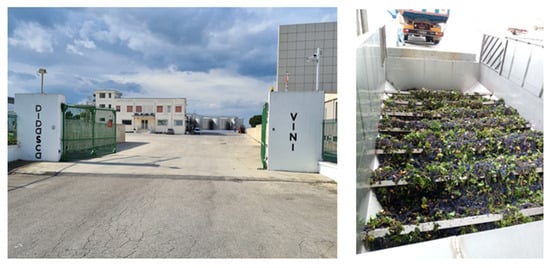
Figure 1.
Didasca Vini S.r.l. company, site of the experimental tests (left); unloading of the grapes (right).
Table 1 shows the main technical features of the machines in the wine production line involved in the experimental tests.

Table 1.
Main characteristics of the machinery used for the tests.
In the experimental trials, a homogeneous batch of Primitivo grapes was processed, hand-picked and taken within 1 h of harvesting to the Didasca Vini winery, where a “ready-to-drink” wine production line was set up. A net quantity of 1000 hL of destemmed grapes was placed in two identical 1200 hL vertical steel vats (Figure 2). Both tanks were monitored and equipped with an automated assembly system and a pneumatic marc breaker. As soon as both tanks were filled, the first cap was broken by a pneumatic system. During fermentation, however, only the automatic pump-over system was used in one of the two tanks, and only the pneumatic cap-breaking system in the other.
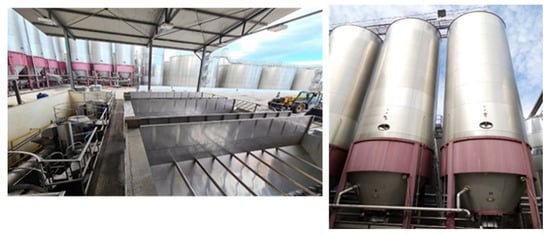
Figure 2.
Designated area of the winery for grape unloading and destemming (left); monitored tanks during experimental trials (right).
At the end of turbulent fermentation, the processed must in each tank was unloaded and sent to a mechanical racking machine (Table 1). The racking was carried out by draining the must through the total drain valve of the tank connected to an external piston pump (Table 1). The extraction of the pomace was carried out by an extraction group set up at a speed of 5 rpm (Figure 3); the pomace was transported using an auger feeding a peristaltic pump, which, in turn, connected to the press drainage line (Figure 3 and Figure 4) where the pomace was subjected to increasing pressure from 10 bar to 70 bar.

Figure 3.
Details of the draining unit of one of the tanks (left); draining pressing line (right).

Figure 4.
Pumps used for racking: peristaltic (left); piston (right).
2.1. Traditional Wine Tank with Automatic Pump-Over
The pump-over system used in one of the two tanks studied (Figure 5) was based on intensive low-pressure spraying of the must onto the marc cap, which remained intact. The pump-over was carried out without the addition of oxygen by means of an electric centrifugal pump with set-back impeller (Table 1), which took the must from the bottom and pushed it to the top of the vinificator through an external pipe. The must fell back onto the sprinkler plate and broke up, allowing it to be spread evenly over the cap.
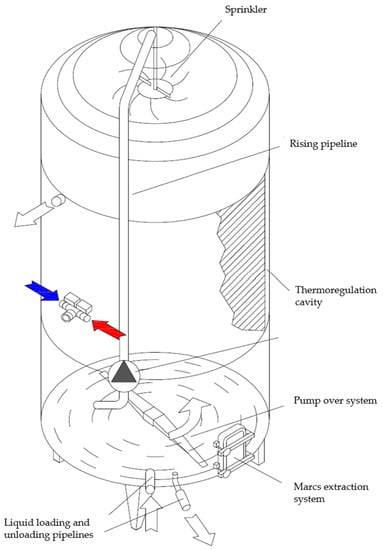
Figure 5.
Schematic representation of the pump-over system carried out in one of the two vinificators studied based on the intensive spraying of must on the cap.
By varying the speed of the sprayer, the must is distributed over the entire surface of the cap in a cycle defined by a gradual increase in speed until the maximum speed is reached and maintained for a certain time. The pump and the sprayer were controlled simultaneously by a timer, which could be operated with the working cycle programme, allowing the following parameters to be set: total cycle time, pumping time, pumping pause time and must temperature.
For the first 40 h of fermentation, a pump-over of 20 min every 2 h was set; then, for the following 90 h of fermentation, a pump-over of 15 min every 2 h was set.
2.2. Innovative Wine Tank with a Pneumatic Cap for Breaking up the Marc
The FOLLARIA pneumatic cap break system (Figure 6 and Figure 7), patented and manufactured by Itest s.r.l.—Corato (BA), Italy, was monitored at one of the two wineries studied. This technology uses the must/wine density measurement to trigger the combined jets of compressed air through a series of nozzles on the side wall of the tank. The air is delivered from all the nozzles at the same time, without shifting between nozzles. The modulated air jets impart motion to the liquid, causing the cap to break, flood and dip. As a result of the pulses from the air jets, transverse cracks are created in the cap in all directions until disintegration of the mass is achieved (Figure 6).
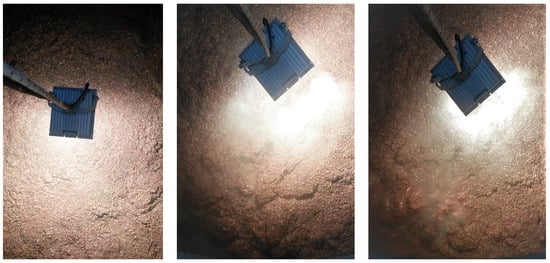
Figure 6.
Grape marc cap in the process of breaking with the pneumatic system.
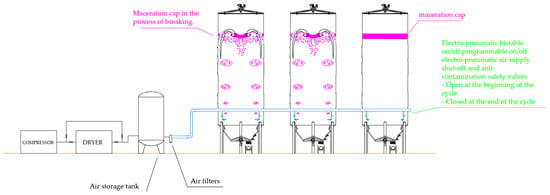
Figure 7.
Layout of the pneumatic cap-breaking system installed in a tank, with the cap in the process of breaking.
Compressed air is produced by the compressor of the winery’s centralised system and stored at a pressure of 7 bar in 4 tanks with a capacity of 8000 L, located in different parts of the winery (Table 1). Before entering the tank, the air is dehumidified and filtered; eight nozzles are installed in the tank under study (Figure 8).
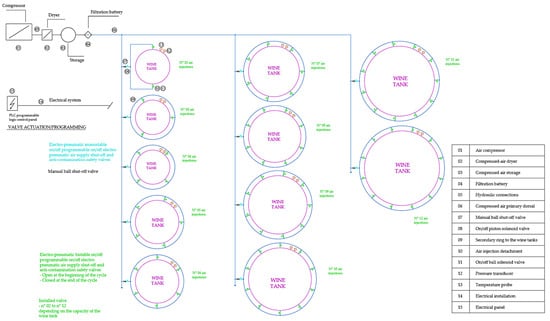
Figure 8.
Schematic representation of the pneumatic cap-breaking system; the monitored tank is the one with 8 nozzles.
- Compressor;
- Compressed air tank;
- Air treatment coil (dehumidification and filtration);
- Primary pipe;
- n. 2 shut-off valves;
- On/off solenoid valve (opening time: 0.001 s–20 s; pause/work time: 0.001 s–120 s; number of cycles: 2–100);
- Pressure transducers;
- Temperature probes;
- Density meters;
- Electrical panel with PLC.
2.3. Experimental Tests
The two wine tanks were filled at the same time on 3 September 2021 and, after 24 h, the cap was broken by the pneumatic system using 30 insufflations of compressed air at 4–6 bar for 1 s, every 3 s, for a total of 3 min. Since the aim was to produce a “ready-to-drink” wine, representative parameters of vinification efficiency and functionality were monitored during alcoholic fermentation. To this end, fermenting must samples were taken daily at three different heights in the wine tank: 4 m, 9 m, and 14 m. The following analytical evaluations were carried out on each sample with the following instruments: density, specific gravity, reducing sugars, effective degree, optical density (420, 520, 620), colour intensity, colour tone, total polyphenols, pH and total acidity (Table 2).

Table 2.
Analytical evaluations carried out during experimental tests on fermenting must.
Functional performance was evaluated by monitoring vinification time, racking time, the quantity of must wine obtained at the end of the draining–pressing process and energy consumption.
A Yokogawa Power Quality Meter and Analyser with data logger function, model CW121, was used to evaluate the active electrical power consumed by the machine motors; such an instrument makes it possible to measure the energy consumption of single-phase and three-phase loads, considering the possible load imbalance in each phase. The measurements were made by inserting the instrument leads into the power line between the electrical cabinet and the motor of the machine under consideration (Figure 9).
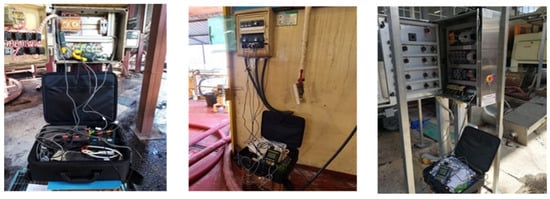
Figure 9.
Energy consumption measuring instrument connected to the electrical panels: the winemakers (left), compressors (center), and the draining press (right).
Total energy consumption was measured by connecting the instrument cables to the machine’s power line and was started at each pumping cycle in the tank where the traditional system was monitored and at each compressed air insufflation cycle in the tank where the pneumatic system was monitored. Similarly, the energy consumption was measured during the racking phase of each tank studied: the pomace extraction unit, the external racking pump, and the transfer screw to the racking press. Finally, the same measurements were carried out during the operation of the racking press while treating the mass discharged from each wine tank.
Three tests were carried out for each machine studied, and statistical analysis was performed using Statistics 12.0 software (StatSoft Inc., Tulsa, OK, USA); an analysis of variance was performed, and the results were compared using Tukey’s multiple interval test with a significance level = 0.05.
3. Results and Discussion
3.1. Power Consumption Results
The graphs of the power consumption over time during fermentation (Figure 9; Table 3 and Table 4) are quite clear in their interpretation. The electric motors used were those of the transfer pump and the diffuser in the wine tank with this circulation system and those of the compressor in the wine tank with the pneumatic system.
In the first case, the average active power consumption was 11.0 kW (Figure 10; Table 5), corresponding to an energy consumption of 197.0 kWh and a specific consumption of 0.20 kWh/hL (Table 3). Similar electrical consumption of pumps was found in another study carried out on pneumatic presses. In the second case, however, the average active power consumption was 25 kW (Figure 10; Table 4), corresponding to a power consumption of 2.6 kWh, a specific power input of 0.025 kW/hL, and a specific power consumption of 0.0026 kWh/hL (Table 4).
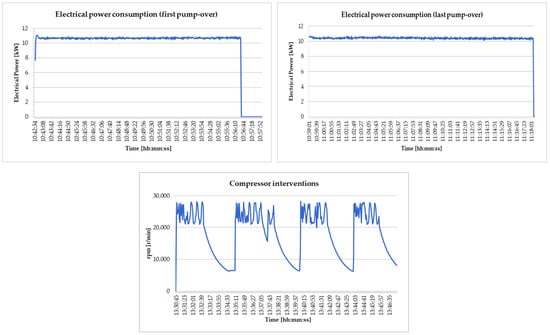
Figure 10.
Electrical power consumption during the first and last pump-over (above) and during the interventions of the compressor of the compressed air plant (below).
The specific consumption of the pneumatic system is 80 times lower, thanks to the particularly energy-efficient method of breaking the cap. In fact, 378 insufflations, each lasting 1 s, were sufficient to carry out the disintegration operations (Figure 11) of a solid mass that, in a 1000 hL wine tank, often exceeded a thickness of 1.5 m. In addition, the technique used allowed for the use of a centralised compressed air system, rather than low-power machines on board the wine tank, with the advantage of having a high-power compressor that always runs at the optimum speed with maximum power factor. In addition, the pneumatic system allowed for punctual insufflation interventions, depending on the density monitoring of the must wine under fermentation (Figure 10). On the other hand, in the pump-over system, the interventions were programmed over time, with the possibility that some of them may be superfluous or, on the contrary, insufficient.
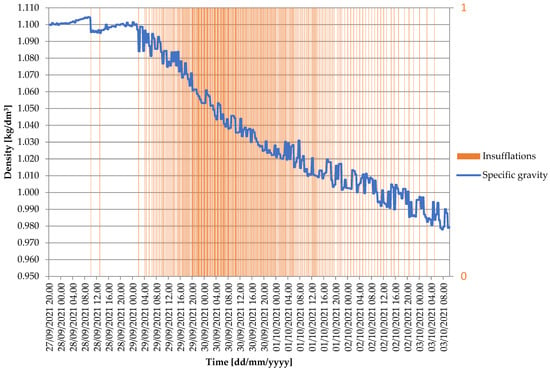
Figure 11.
Variation in density over time (blue line) of must wine in fermentation during the test in the fermenter where the pneumatic system was used; the red vertical lines correspond to the injections of compressed air (total no. 378).
During the racking phase of the tank in which the pump-over was carried out, the pomace extraction unit had to run for 110 min, with an average power input of 1.16 kW (Figure 12; Table 3) and a power consumption of 2.12 kWh or 0.0021 kWh/hL (Table 3). On the other hand, the tank extractor using the pneumatic system operated for 45 min, with an average power input of 1.57 kW (Figure 12; Table 4) and a power consumption of 1.23 kWh, or 0.0012 kWh/hL (Table 4), i.e., almost half the power consumption in the latter tank.

Figure 12.
Electrical power absorption of the marcs extraction unit during racking: in the fermenter where pump-over was performed (left) and in the fermenter where compressed air was used (right).
This can be explained by the different consistency of the unloaded mass, which, in the case of the pneumatic system, was more liquid, with a higher percentage of suspended solids, and could be easily unloaded by gravity. On the other hand, in the tank where the pump-over was used, the pomace was more consistent and, therefore, a lower percentage of solids was removed with the liquid, requiring a longer and more energetic action of the extraction unit.

Table 3.
Energy parameters of the vinification line in which the system of pump-over during the fermentation phase was used.
Table 3.
Energy parameters of the vinification line in which the system of pump-over during the fermentation phase was used.
| Parameters | Pump-Over Group (Pump + Diffuser) | Extraction Group | Drain-Pressing Line | Total Values |
|---|---|---|---|---|
| Average active power absorbed | 11 kW | 1.16 kW | 8.9 kW | / |
| Electric consumption | 197 kWh | 2.12 kWh | 34.1 kWh | 233.22 kWh |
| Specific energy | 0.200 kWh/hLmust | 0.0021 kWh/hLmust | 0.046 kWh/hLwine | 0.320 kWh/hLwine |
| Wine obtained | / | / | 740 hL | 740 hL |

Table 4.
Energy parameters of the vinification line in which the pneumatic system was used during the fermentation phase.
Table 4.
Energy parameters of the vinification line in which the pneumatic system was used during the fermentation phase.
| Parameters | Compressor | Extraction Group | Pressing Draining Line | Total Value |
|---|---|---|---|---|
| Average active power absorbed | 25 kW | 1.57 kW | 11.78 kW | / |
| Electric consumption | 2.6 kWh | 1.23 kWh | 32.4 kWh | 18.23 kWh |
| Specific energy | 0.0026 kWh/hLmust | 0.0012 kWh/hLmust | 0.0430 kWh/hLwine | 0.0240 kWh/hLwine |
| Wine obtained | / | / | 760 hL | 760 hL |
The above was also confirmed by the evolution of the energy consumption of the draining–pressing lines (Figure 13; Table 3 and Table 4). In fact, during the processing of musts from the fermenters undergoing racking, after a short start-up phase, there was a succession of two phases, in which the active power absorbed by the line was between 2.0 kW and 4.5 kW, for a total duration of about 90 min; this trend was interrupted for about 10 min between phases, during which the line absorbed an average of 10.2 kW (Figure 13). At the end of the second phase, the power increased again and varied between 10.0 kW and 18 kW for the last 80 min (Figure 13).

Figure 13.
Electric power absorption of the draining–pressing line: the mass unloaded from the fermenter in which the pump-over was carried out (left) and the mass unloaded from the fermenter in which compressed air was used (right).
3.2. Analytical Results
On the other hand, for the mass processing from the tank where the pneumatic system was used, it was found that the active power consumption of the draining–pressing line was more regular over time, stabilising at values between 8.0 kW and 14.0 kW (Figure 13). In total, the first line operated for 230 min, with an average power consumption of 8.9 kW, whereas the second line operated for 165 min, with an average power consumption of 11.78 kW.
It is, therefore, clear that the second line processed a more homogeneous mass, allowing all sections to be processed continuously, without interruption, in a shorter time and with lower total energy consumption (Table 3 and Table 4). On the other hand, the first line worked discontinuously, leaving the pressing section idle for a long time, to which, during the last 80 min, a high flow rate of very compact and poorly draining marc was fed, requiring high pressures in the draining section to extract the wine, with equally high-power consumption. Despite the lower average power consumption values, the draining–pressing line, which processed the mass from the fermenter where the racking took place, consumed slightly more energy: 34.1 kWh or 0.046 kWh/hL compared to 32.4 kWh or 0.043 kWh/hL (Table 3 and Table 4).
In addition to the aforementioned advantages, a higher liquid content at the time of draining and pressing may lead to a greater presence of solids in the wines that are to ferment slowly, with a consequent increase in the formation of lees in the tanks and the necessity to rake off the lees more often. The overall results are, of course, influenced by the very low energy consumption during the vinification phase using the pneumatic system (Table 4): 18.23 kWh and 0.024 kWh/hLwine for the pneumatic system, i.e., more than ten times lower than the line using pump-over (233.22 kWh and 0.32 kWh/hLwine).
During the experimental trials, the fermentations stopped when similar parameters were reached in both wine tanks (Table 7), corresponding to a “ready-to-drink” wine. It is, therefore, a product intended for medium market placement, to be obtained in a short time and at a low total cost. From this point of view, the analysis in Table 5, Table 6 and Table 7 shows that the parameters of the start of fermentation (Table 5) evolve faster in the tank where the pneumatic break of the cap is realised, with the clarification parameters being reached 24 h before the second tank (Table 7). This allows for better utilisation of the tank in relation to the needs of the winery during the harvest.

Table 5.
Analytical evaluations carried out on musts in winemakers equipped with different circulation systems studied. Fermentation begins.
Table 5.
Analytical evaluations carried out on musts in winemakers equipped with different circulation systems studied. Fermentation begins.
| Parameters | Wine Tank with Pneumatic Cap Breaks | Standard Deviation | Wine Tank with Pump-Over System | Standard Deviation |
|---|---|---|---|---|
| Density | 1.08 g/mL | 0.07 | 1.08 g/mL | 0.06 |
| Reducing weight | 196 g/L | 15.43 | 189 g/L | 10.38 |
| Effective degree | 1.97° | 0.11 | 2.12° | 0.11 |
| O.D. 420 | 1.30 | 0.06 | 1.21 | 0.06 |
| O.D. 520 | 2.80 | 0.14 | 2.59 | 0.17 |
| O.D. 620 | 0.50 | 0.03 | 0.30 | 0.02 |
| Dye intensity | 4.60 | 0.19 | 4.10 | 0.18 |
| Tonality | 0.45 | 0.02 | 0.45 | 0.034 |
| Total polyphenols | 740 mg/L | 32.03 | 592 mg/L | 22.68 |
| pH | 3.45 | 0.11 | 3.45 | 0.12 |
| Total acidity | 6.50 g/L | 0.32 | 5.50 g/L | 0.20 |
| Pick up time (hours after hat break) | 24 h | 24 h |

Table 6.
Analytical evaluations carried out on musts in wine tanks equipped with the different circulation systems studied (mid-fermentation).
Table 6.
Analytical evaluations carried out on musts in wine tanks equipped with the different circulation systems studied (mid-fermentation).
| Parameters | Wine Tank with Pneumatic Cap Breaking | Standard Deviation | Wine Tank with Pump-Over System | Standard Deviation |
|---|---|---|---|---|
| Density | 1.05 g/mL | 0.06 | 1.03 g/mL | 0.05 |
| Reducing weight | 132 g/L | 6.25 | 79 g/L | 3.79 |
| Effective degree | 5.93° | 0.231 | 8.98° | 0.34 |
| O.D. 420 | 2.00 | 0.101 | 1.94 | 0.08 |
| O.D. 520 | 3.20 | 0.165 | 2.89 | 0.13 |
| O.D. 620 | 0.80 | 0.036 | 0.80 | 0.03 |
| Dye intensity | 6.00 | 0.247 | 5.63 | 0.23 |
| Tonality | 0.60 | 0.027 | 0.67 | 0.02 |
| Total polyphenols | 1.48 mg/L | 0.083 | 1.64 mg/L | 0.09 |
| pH | 3.50 | 0.139 | 3.47 | 0.17 |
| Total acidity | 7.00 g/L | 0.381 | 6.85 g/L | 0.29 |
| Pick up time (hours after hat break) | 72 h | 96 h |

Table 7.
Analytical evaluations carried out on musts in wine tanks equipped with the different circulation systems studied. End of fermentation.
Table 7.
Analytical evaluations carried out on musts in wine tanks equipped with the different circulation systems studied. End of fermentation.
| Parameters | Wine Tank with Pneumatic Cap Breaking | Standard Deviation | Wine Tank with Pump-Over System | Standard Deviation |
|---|---|---|---|---|
| Density | 0.99 g/mL | 0.05 | 0.99 g/mL | 0.03 |
| Reducing weight | 0.60 g/L | 0.02 | 0.60 g/L | 0.02 |
| Effective degree | 13.88° | 0.73 | 13.70° | 0.76 |
| O.D. 420 | 2.11 | 0.08 | 2.00 | 0.10 |
| O.D. 520 | 3.70 | 0.24 | 3.00 | 0.16 |
| O.D. 620 | 1.00 | 0.03 | 1.00 | 0.04 |
| Dye intensity | 6.81 | 0.32 | 6.50 | 0.36 |
| Tonality | 0.60 | 0.02 | 0.66 | 0.03 |
| Total polyphenols | 2.01 mg/L | 0.11 | 1.85 mg/L | 0.10 |
| pH | 3.60 | 0.15 | 3.60 | 0.15 |
| Total acidity | 7.00 g/L | 0.29 | 7.00 g/L | 0.27 |
| Pick up time (hours after hat break) | 120 h | 144 h |
At mid-fermentation, a higher reducing sugar content was found in the must of the winemaker using the pneumatic system: 132 g/L compared to 79 g/L (Table 6). This result shows that the yeast activity was more intense in the tank where the pump-over was carried out during the intermediate stages of alcoholic fermentation, but it also emphasises the need for more rigorous monitoring and control of temperature, an important and influential factor from a management and energy point of view.
At mid-fermentation, the total colour intensity increased by 30% in the must from the tank equipped with the pneumatic system and by 37% in the must from the tank with the pump-over system (Table 5 and Table 6). This trend was confirmed at the end of fermentation: +48% in the must from the tank equipped with a pneumatic system and +58.5% in the must from the tank where pump-over was carried out (Table 5 and Table 6). On the other hand, the spectrophotometric analysis of the optical density 520, representative of the presence of red colour, showed an increase of 14% in the middle of fermentation (Table 6) and 32% at the end of fermentation in the must vinified with the pneumatic system (Table 7). In the must vinified with the pump-over system, however, the increases were less pronounced: 11% and 15.8%, respectively, at the middle and end of fermentation (Table 6 and Table 7).
Overall, the systems gave comparable results in terms of colour extraction since the wines obtained had similar colour values: 0.60 with the pneumatic system and 0.66 with the use of fulling.
However, the use of the pneumatic system allowed for a greater extraction of red colour from the earliest stages, a much sought-after aspect in the production of “ready-to-drink” wines to be marketed quickly.
In terms of total polyphenols, i.e., the sum of compounds extracted from both the skins and the seeds, it was found that the must from the traditional vat was higher at mid-fermentation. This is because, at this stage of fermentation, the traditional vat was at a more advanced stage of fermentation itself and, therefore, had a higher alcohol content, which favours a greater extraction of these compounds. At the end of fermentation, on the other hand, there was a greater increase in total polyphenols in the pneumatic fermenter, because it is noted that in the latter fermenter, there was a greater development of alcohol content during the last stages of fermentation. This favoured a greater extraction than in the first fermenter. In addition, in the pneumatic system, the solid parts of the must were always in circulation (not forming the cap), which favoured a higher extraction.
The above can be explained by the dynamics of pneumatic cap breaking applied to the primitive grapes from which the crushed grapes were obtained in the fermentation studied.
In this system, the cap breakage is achieved by cracks created in the mass by air injected simultaneously from different points on the side of the tank; the air penetrates into spaces where it is much more difficult for the liquid to penetrate, causing the cracks to widen, allowing the liquid phase to rise and the cap to break in different areas. In the case of Primitivo grapes, which are characterised by very thin skins, no cellular or extracellular surfaces can be identified as barriers to the escape of liquid, so a less invasive extraction is desirable.
On the other hand, the fact that, with this type of pressing, the chemical and physical characteristics of the wine obtained with the pneumatic system are comparable to those of the wine obtained with mass circulation by pumping over is certainly a positive result, both in terms of the very favourable functional and energetic performance and in terms of the margins for improvements that characterise this system. For example, the size, frequency, and sequence of the insufflations can be adapted to the characteristics of the crushed grapes undergoing fermentation, in order to obtain an optimum coupling of the resonance frequency of the liquid with that of the solid and to obtain the desired maceration.
4. Conclusions
In this work, an experimental monitoring of two types of product circulation systems in fermentation was carried out in a winery in Apulia, processing destemmed grapes of the Primitivo variety intended for red wine production, to produce “ready-to-drink” wine. In particular, the functional performance and energy consumption of two identical vinification lines were monitored, in which the only variable was the system for circulating the fermenting must: pump-over or pneumatic cap breaking.
The line using pump-over achieved fermentation in 144 h, racking in 110 min and draining–pressing in 230 min; the line using pneumatic cap breaking in fermentation had shorter times: 120 h for fermentation, 45 min for racking and 165 min for draining–pressing.
The total energy consumption was very low in the fermentation phase using the pneumatic system: 18.23 kWh and 0.024 kWh/hLwine, more than ten-times lower than in the line using pump-over: 233.22 kWh and 0.32 kWh/hLwine. From an analytical point of view, the performance obtained with pump-over showed the effectiveness of this circulation system on Primitivo grapes, characterized by very thin skins, on which the pump-over leaching is particularly suitable, both for promoting yeast activity and for obtaining color extraction. From this point of view, the pneumatic system studied was too energetic compared to the characteristics of the fermenting mass.
On the other hand, for this type of grape pressing, the fact that the chemical and physical characteristics of the wine obtained with the pneumatic system are comparable to those of the wine obtained with mass circulation by pumping over is certainly a positive result, both in terms of the very favorable functional and energetic performance and the margins of improvement that can be identified for this system.
In conclusion, for the grapes and type of wine studied, the pneumatic system showed better functional performance in terms of vinification speed and energy consumption.
As far as energy consumption is concerned, it is essential for a complete study of any food processing system, since saving energy allows the company to be competitive without compromising product quality; energy must be considered a raw material for obtaining a quality product at affordable prices. From this point of view, the results obtained highlight, in particular, the need for further studies on equipment design. Indeed, the potential for improvements identified could bring significant benefits in terms of wine production costs while maintaining the quality standards required for “ready to drink” wines.
Author Contributions
Conceptualization, B.B. and F.C.; methodology, B.B., F.C. and F.G.; investigation, B.B., F.C., M.O., C.P. and F.G.; data curation, B.B., F.C., F.G. and M.O.; writing—original draft preparation, F.G., B.B., M.O. and F.C.; writing—review and editing, M.O., F.G. and B.B.; visualization, B.B., F.C., R.R., M.O. and F.G.; supervision, B.B. All authors have read and agreed to the published version of the manuscript.
Funding
This research received no external funding.
Institutional Review Board Statement
Not applicable.
Informed Consent Statement
Not applicable.
Data Availability Statement
Not applicable.
Conflicts of Interest
The authors declare no conflict of interest. The funders had no role in the design of the study; in the collection, analyses, or interpretation of data; in the writing of the manuscript; or in the decision to publish the results.
References
- Bianchi, B.; Cavone, G.; Cice, G.; Tamborrino, A.; Amodio, M.; Capotorto, I.; Catalano, P. CO2 Employment as Refrigerant Fluid with a Low Environmental Impact. Experimental Tests on Arugula and Design Criteria for a Test Bench. Sustainability 2015, 7, 3734. [Google Scholar] [CrossRef]
- Bianchi, B.; Tamborrino, A.; Giametta, F.; Squeo, G.; Difonzo, G.; Catalano, P. Modified Rotating Reel for Malaxer Machines: Assessment of Rheological Characteristics, Energy Consumption, Temperature Profile, and Virgin Olive Oil Quality. Foods 2020, 9, 813. [Google Scholar] [CrossRef]
- Rahimifard, S.; Seow, Y.; Childs, T. Minimising Embodied Product Energy to Support Energy Efficient Manufacturing. CIRP Ann. Manuf. Technol. 2010, 59, 25–28. [Google Scholar] [CrossRef]
- Garwood, T.L.; Hughes, B.R.; Oates, M.R.; O’Connor, D.; Hughes, R. A Review of Energy Simulation Tools for the Manufacturing Sector. Renew. Sustain. Energy Rev. 2018, 81, 895–911. [Google Scholar]
- Dolgui, A.; Ivanov, D.; Sethi, S.P.; Sokolov, B. Scheduling in Production, Supply Chain and Industry 4.0 Systems by Optimal Control: Fundamentals, State-of-the-Art and Applications. Int. J. Prod. Res. 2019, 57, 411–432. [Google Scholar]
- Tamborrino, A.; Catalano, F.; Berardi, A.; Bianchi, B. New Modelling Approach for the Energy and Steam Consumption Evaluation in a Fresh Pasta Industry. Chem. Eng. Trans. 2021, 87, 409–414. [Google Scholar] [CrossRef]
- Tamborrino, A.; Perone, C.; Catalano, F.; Squeo, G.; Caponio, F.; Bianchi, B. Modelling Energy Consumption and Energy-Saving in High-Quality Olive Oil Decanter Centrifuge: Numerical Study and Experimental Validation. Energies 2019, 12, 2592. [Google Scholar] [CrossRef]
- Perone, C.; Catalano, F.; Giametta, F.; Tamborrino, A.; Bianchi, B.; Ayr, U. Study and Analysis of a Cogeneration System with Microturbines in a Food Farming of Dry Pasta. Chem. Eng. Trans. 2017, 58, 499–504. [Google Scholar] [CrossRef]
- Catalano, F.; Perone, C.; Iannacci, V.; Leone, A.; Tamborrino, A.; Bianchi, B. Energetic Analysis and Optimal Design of a CHP Plant in a Frozen Food Processing Factory through a Dynamical Simulation Model. Energy Convers. Manag. 2020, 225, 113444. [Google Scholar] [CrossRef]
- Bianchi, B.; Catalano, F.; Oliveto, R.; Ricciardi, S. Dynamic Simulation Driven Design and Management of Production Facilities in Agricultural/Food Industry. Proc. Acta Hortic. 2021, 1311, 241–248. [Google Scholar]
- Catalano, F.; Leone, A.; Bianchi, B.; Tamborrino, A. A New Tool for Food Industrial Plant Simulation and IoT Control. Chem. Eng. Trans. 2021, 87, 367–372. [Google Scholar] [CrossRef]
- Perone, C.; Catalano, P.; Giametta, F.; La Fianza, G.; Brunetti, L.; Bianchi, B. Controlled Mechanical Ventilation to Reduce Primary Energy Consumption in Air Conditioning of Greenhouses. In Lecture Notes in Civil Engineering; Coppola, A., Di Renzo, G.C., Altieri, G., D’Antonio, P., Eds.; Springer International Publishing: Cham, Switzerland, 2020; Volume 67, pp. 399–407. [Google Scholar]
- Tamborrino, A.; Catalano, F.; Leone, A.; Bianchi, B. A Real Case Study of a Full-Scale Anaerobic Digestion Plant Powered by Olive By-Products. Foods 2021, 10, 1946. [Google Scholar] [CrossRef]
- Ulyev, L.M.; Kanischev, M.V.; Chibisov, R.E.; Vasilyev, M.A. Heat Integration of an Industrial Unit for the Ethylbenzene Production. Energies 2021, 14, 3839. [Google Scholar] [CrossRef]
- Thollander, P.; Palm, J. Improving Energy Efficiency in Industrial SMEs. In Improving Energy Efficiency in Industrial Energy Systems; Springer: Berlin/Heidelberg, Germany, 2013. [Google Scholar]
- De Vita, P.; De Vita, G. Manuale Di Meccanica Enologica: Richiami Di Fisica, Saldature, Cantina, Vasi Vinari, Vendemmia, Ammostatura, Chiarifica, Vinificatori, Filtri, Impianti Solari, per Concentrazione Mosti, Elettrici, Di Refrigerazione, Di Pastorizzazione, per Spumanti, Di Imbottigliamento, Distillazione, Depurazione, Pompe, Normative Specifiche; Hoepli: Milan, Italy, 2011. [Google Scholar]
- Kubule, A.; Zogla, L.; Ikaunieks, J.; Rosa, M. Highlights on Energy Efficiency Improvements: A Case of a Small Brewery. J. Clean. Prod. 2016, 138, 275–286. [Google Scholar] [CrossRef]
- Colombié, S.; Malherbe, S.; Sablayrolles, J.M. Modeling of Heat Transfer in Tanks during Wine-Making Fermentation. Food Control. 2007, 18, 953–960. [Google Scholar] [CrossRef]
- Varma, R.R. Heat Transfer in Unitanks. Mon. Fur Brauwiss. 1999, 52, 4–8. [Google Scholar]
- López, A.; Secanell, P. A Simple Mathematical Empirical Model for Estimating the Rate of Heat Generation during Fermentation in White-Wine Making. Int. J. Refrig. 1992, 15, 276–280. [Google Scholar] [CrossRef]
- le Roux, J.M.W.; Purchas, K.; Nell, B. Refrigeration Requirements for Precooling and Fermentation Control in Wine Making. S. Afr. J. Enol. Vitic. 2017, 7, 6–13. [Google Scholar] [CrossRef]
- Manzocco, L.; Maltini, E.; Lerici, C.R. Changes of Some Thermal and Physical Properties in Model Systems Simulating an Alcoholic Fermentation. J. Food Process. Preserv. 1998, 22, 1–12. [Google Scholar] [CrossRef]
- Malherbe, S.; Fromion, V.; Hilgert, N.; Sablayrolles, J.M. Modeling the Effects of Assimilable Nitrogen and Temperature on Fermentation Kinetics in Enological Conditions. Biotechnol. Bioeng. 2004, 86, 261–272. [Google Scholar] [CrossRef]
- Williams, L.A.; Boulton, R. Modeling and Prediction of Evaporative Ethanol Loss During Wine Fermentations. Am. J. Enol. Vitic. 1983, 34, 234–242. [Google Scholar] [CrossRef]
- Genc, M.; Genc, S.; Goksungur, Y. Exergy Analysis of Wine Production: Red Wine Production Process as a Case Study. Appl. Therm. Eng. 2017, 117, 511–521. [Google Scholar] [CrossRef]
- Glories, Y. Recherches Sur La Matiere Colorant Des Vins Rouges. Ph.D. Thesis, Université de Bordeaux II, Bordeaux, France, 1978. [Google Scholar]
- Pettinelli, S.; Pardini, L.; De Angeli, G.; Bianchi, A.; Najar, B.; Cerreta, R.; Bellincontro, A.; Floridia, G.; Mencarelli, F. Innovative “Soft” Maceration Techniques in Red Grape Fermentation. Beverages 2022, 8, 62. [Google Scholar] [CrossRef]
- Alimonti, C.; Pecci, G. Back Analysis of a Horizontal Geothermal Plant Implemented in a Wine Production Process. Sustainability 2022, 14, 157. [Google Scholar] [CrossRef]
- Lin, Z.; Xie, Q.; Qian, Q.; Zhang, T.; Zhang, J.; Zhuang, J.; Wang, W. A Real-time Realization Method for the Pneumatic Positioning System of the Industrial Automated Production Line Using Low-cost on–off Valves. Actuators 2021, 10, 260. [Google Scholar] [CrossRef]
- Perone, C.; Bianchi, B.; Catalano, F.; Orsino, M. Experimental Evaluation of Functional and Energy Performance of Pneumatic Oenological Presses for High Quality White Wines. Sustainability 2022, 14, 8033. [Google Scholar] [CrossRef]
Disclaimer/Publisher’s Note: The statements, opinions and data contained in all publications are solely those of the individual author(s) and contributor(s) and not of MDPI and/or the editor(s). MDPI and/or the editor(s) disclaim responsibility for any injury to people or property resulting from any ideas, methods, instructions or products referred to in the content. |
© 2023 by the authors. Licensee MDPI, Basel, Switzerland. This article is an open access article distributed under the terms and conditions of the Creative Commons Attribution (CC BY) license (https://creativecommons.org/licenses/by/4.0/).